
About UsThe Numismatic Bibliomania Society is a non-profit organization promoting numismatic literature. For more information please see our web site at coinbooks.org SubscriptionsThose wishing to become new E-Sylum subscribers (or wishing to Unsubscribe) can go to the following web page link MembershipThere is a membership application available on the web site Membership Application To join, print the application and return it with your check to the address printed on the application. Membership is only $15 to addresses in the U.S., $20 for First Class mail, and $25 elsewhere. For those without web access, write to: David M. Sundman, Secretary/TreasurerNumismatic Bibliomania
Society AsylumFor Asylum mailing address changes and other membership questions, contact David at this email address: dsundman@LittletonCoin.com SubmissionsTo submit items for publication in The E-Sylum, just Reply to this message, or write to the Editor at this address: whomren@coinlibrary.com
BUY THE BOOK BEFORE THE COINYou won't regret it! |
- WAYNE'S WORDS: THE E-SYLUM DECEMBER 9, 2012
- KOLBE-FANNING LITERATURE SALE #127 CLOSES JANUARY 12, 2013
- NEW BOOK: THE HAWAII OVERPRINT CURRENCY CATALOG
- NEW BOOK: CONFEDERATE STATES PAPER MONEY, 12TH EDITION
- NEW BOOK: A NEW LOOK AT NEWFOUNDLAND VARIETIES
- BOOK REVIEW: JOHN MERCANTI’S AMERICAN SILVER EAGLES
- PAUL KOPPENHAVER 1932-2012
- GERALD JOHNSON 1928 - 2012
- NOTES FROM E-SYLUM READERS: DECEMBER 9, 2012
- TWO EARLY U.S. COINAGE DESIGNS THAT NEVER WERE
- QUERY: WERE MANY NORWEB CANADIAN LARGE CENTS SLABBED?
- QUERY: CONTACT MARKS: WHERE AND HOW?
- COPPERHEADS AND THE U.S. MINT OATH OF ALLEGIANCE MEDAL
- YALE COIN COLLECTION OPENS IN NEW ART MUSEUM
- THE LABOR EXCHANGE NOTES OF GIOVANNI DEBERNARDI
- PICTURE GALLERY OF U.S. NUMISMATIC GREATS
- 2013 COIN OF THE YEAR AWARD WINNERS
- BRITISH MUSEUM EXHIBITS ST ALBANS ROMAN COIN HOARD
- THE BATH ROMAN COIN HOARD
- SPINK SELLS RICHARD III COIN FOUND NEAR BATTLEFIELD
- NUMISMATICS IN GOTHA
- PLATINUM COIN "SOLUTION" TO U.S. DEBT CRISIS FLOATED
- DRAMATIC LIBRARY PATRON RESCUE
- FEATURED WEB SITE: THE CANADIAN 1859 LARGE CENT
WAYNE'S WORDS: THE E-SYLUM DECEMBER 9, 2012

New subscribers this week include Max Lynds. Welcome aboard! We have 1,614 email subscribers, plus 201 followers on Facebook.
This week we open with information about the January 12, 2013 literature sale from Kolbe-Fanning, three new numismatic and upcoming books, and a review of American Silver Eagles.
Other topics include the Yale University numismatic department, proposed early U.S. coin designs, Norweb Canadian large cents, Hawaii overprint notes, contact marks, copperheads, the Grand Duke Mikhailovich collection of Russian coins, and the labor exchange notes of Giovanni DeBernardi.
To learn more about Steve Tanenbaum's Civil War store card collection, varieties of Newfoundland coins, "Beware of the Copperheads", a book on emergency scrip issues of 1893 to 1915, and some great Coin of the Year winners, read on. Have a great week, everyone!
Wayne Homren
Editor, The E-Sylum
KOLBE-FANNING LITERATURE SALE #127 CLOSES JANUARY 12, 2013
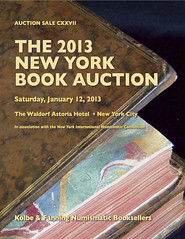 Kolbe & Fanning Numismatic Booksellers have completed the catalogue of their 2013 New York Book Auction, to be held at the Waldorf-Astoria Hotel in New York City on Saturday, January 12, in conjunction with the New York International Numismatic Convention.
Kolbe & Fanning Numismatic Booksellers have completed the catalogue of their 2013 New York Book Auction, to be held at the Waldorf-Astoria Hotel in New York City on Saturday, January 12, in conjunction with the New York International Numismatic Convention.
The sale is composed of 271 lots of high-quality works covering the entire range of numismatics, with the first session focusing on ancient and foreign topics and the second session focusing on U.S. subjects. In addition to a wide variety of standard and specialized books, the sale is notable for including exceptionally important archival materials and unique manuscripts from a variety of sources.
Highlights include:
--Unique and highly important materials from the personal archives of Elvira and Vladimir Clain-Stefanelli, including Elvira’s extraordinary notebooks and Vladimir’s extensive archive on the USAOG controversy.
--An exquisitely bound manuscript dated 1720 by Thomas Compton that may well be the earliest substantive work on the entirety of British coinage.
--An extremely important assemblage of materials on the acquisition, sale and subsequent donation to the National Coin Collection of the exceptional collection of Russian coins belonging to Grand Duke Georgii Mikhailovich.
--Tom Virzi’s full 900-page manuscript on the bronze coins of Magna Graecia, an unpublished work of legendary importance.
--A previously unrecorded Geoffrey Charlton Adams sale with two fine photographic plates.
--William Sheldon’s personal copy of Early American Cents, with the condition census updated throughout in pencil, presented by the author to specialist John W. Adams.
--Personal correspondence and manuscripts by Walter Breen.
--John Eshbach’s exceptional collection of the numismatic works of Charles Steigerwalt.
Bids may be placed via mail, email, phone or fax. As in years past, live internet bidding will be available to participants via the-saleroom.com. Every lot will be illustrated on the-saleroom.com, and bidders may follow along with the auction in real time and place bids as though they were in attendance (prior registration is required). Bids may also be left in advance, to be placed automatically during the sale.
The printed catalogue is being sent to customers on the Kolbe & Fanning mailing list at this time. Others may obtain a printed catalogue by sending $20 to the firm. The catalogue also may be downloaded in PDF form from the Kolbe & Fanning website at www.numislit.com. For full bidding instructions, please see the catalogue and read the terms of sale.
For more information or to place bids before January 7, please contact David Fanning at df@numislit.com or (614) 414-0855. After January 7, please use (614) 256-8915. Bids may not be faxed after January 7, and no bid received in the mail after that date can be entered, as we will be in New York.
Thank you, and we look forward to your participation!
Kolbe & Fanning Numismatic Booksellers LLC
141 W. Johnstown Rd.
Gahanna, OH 43230
(614) 414-0855
Cell (614) 256-8915
Fax (614) 414-0860
df@numislit.com
www.numislit.com
Members ANA, ANS, IAPN
NEW BOOK: THE HAWAII OVERPRINT CURRENCY CATALOG
 After the bombing of Pearl Harbor, Hawaii on December 7, 1941, the U.S. issued
currency overprinted with HAWAII to replace normal U.S. currency circulating in Hawaii. During World War II, this
emergency issue was the only currency allowed to circulate in Hawaii. Both then and now, this series has been
intriguing people. This book takes a deeper look into this popular series.
After the bombing of Pearl Harbor, Hawaii on December 7, 1941, the U.S. issued
currency overprinted with HAWAII to replace normal U.S. currency circulating in Hawaii. During World War II, this
emergency issue was the only currency allowed to circulate in Hawaii. Both then and now, this series has been
intriguing people. This book takes a deeper look into this popular series.
The Hawaii Overprint Currency Catalog is the culmination of viewing thousands of notes and bringing together the knowledge of the industry’s experts and researchers. It explores the history, the printing process and print runs, error notes, short snorters and specially stamped notes, and introduces information that challenges some of the long-held facts. Sharing knowledge. Beginning a discussion.
This in-depth study is thoroughly illustrated in full color with pictures from the leading auction houses and several major collections. The illustrations provide a special opportunity to view notes that will not be seen for years.
The Hawaii Overprint Currency Catalog, compiled by Jeremy Uota (ISBN: 978-0-9840030-5-19), is published by Stuffcyclopedia LLC and available online at www.stuffcyclopedia.com.
Publication Date: 2012
Paperback: 258 pages (full color)
Publisher: Stuffcyclopedia LLC
Language: English
ISBN-13: 978-0-9840030-5-19
Product Dimensions: 8.5 (width) x 11.0 (height) x 0.5 (thick) inches
Weight: 2.2lbs
Contact:
Jeremy A. Uota
jeremy.uota@gmail.com
P.O. Box 4909
Kaneohe, HI 96744
Tel: 808-389-1361
NEW BOOK: CONFEDERATE STATES PAPER MONEY, 12TH EDITION
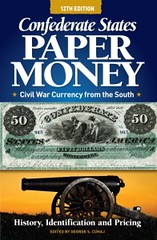 Krause Publications has released a new edition of Confederate States Paper Money, edited by George Cuhaj.
Krause Publications has released a new edition of Confederate States Paper Money, edited by George Cuhaj.
The complete guide to both Confederate States and Southern States issues of America paper money during the Civil War (1861-1865), and the Reconstruction period, is fully illustrated and reflects today’s market values. The first new edition in three years, this is a quick and thorough reference that would appeal to the beginner or expert, collector, dealer or investor.
Features include:
- High quality color images
- Clear and concise presentation of information
- Designed to be easily carried
- Prices in up to six grades
- Data on uncut sheets, advertising notes, errors and facsimile notes distributed for decades from gift shops (we receive many calls about these)
- Fascinating historical insights
Author: George S. Cuhaj
Price: $29.99 (CAN $31.50)
ISBN: 9781440230868
About the Author
George Cuhaj is an experienced and accomplished numismatist and researcher. George is a collector with a passion for this hobby, as well as several others. George, a former cataloger for both Stack's Auction House in New York and the American Numismatic Society offers a wealth of knowledge to the KP line. George continues to develop his network of over 175 dedicated contributors.
For more information, or to order, see:
Confederate States Paper Money, 12th Edition
(www.sellcoinbooks.com/us-paper-money/confederate-states
-paper-money-12th-edition)
Available for immediate sale
Civil War Store Cards
from the estate of
Stephen L. Tanenbaum
Plus: Special Token and Counterstamp News
Ever since I made the announcement that I have acquired a substantial part of the Civil War store card estate collection of the late Stephen L. Tanenbaum excitement has prevailed! The rush to learn more continues as do incoming orders. As I write these words there are still many opportunities, however, specializing in the issues of Connecticut, Illinois (with many rarities), Kentucky (remarkable!), Massachusetts (again notable), Minnesota (a “rare state” with a great selection), New Jersey (a nice selection), New York (amazing!), and Tennessee (opportunities that may never be repeated).
For more than 40 years Steve gathered these, continually improving and upgrading. The vast majority of the tokens are Mint State, many certified by NGC (which Steve was in the midst of doing) and others still in his 2x2 cardboard holders. Rarity-9 (2 to 4 known) tokens abound as do, believe it or not, R-10 (unique) tokens and unlisted varieties.
Numismatic strikes in copper-nickel, overstrikes on other coins, “rare towns,” mint errors, you name it! Each token has been carefully priced to be what I consider to be a very reasonable value. It is significant to say that it has been the rule, not the exception, that those buying tokens have come back to buy more! The quality is remarkable.
If you will send me an e-mail request I will send you my latest list by return e-mail. Nearly all are one-of-a-kind in the estate and are available on a first-come, first served basis.
Special Token and Counterstamp News: Into the spring I will be spending time at my bank sorting through tokens, counterstamped coins (mostly copper cents), and some other items collected since 1955 (!). I will be making a priced list of these. When requesting the CWT list add “QDB tokens too” and when ready I’ll send you a list.
Thank you for your interest!
Box 539
Wolfeboro Falls, NH 03896
Request by e-mail: qdbarchive@metrocast.net
NEW BOOK: A NEW LOOK AT NEWFOUNDLAND VARIETIES
The Newfoundland Numismatic Enthusiasts (NNE) is for collectors of coins, tokens, medals or paper money of Newfoundland (Canada’s most Eastern Province). This club was formed on July 22, 2006 at the RCNA convention held in Niagara Falls, and it’s still thriving today. Current President Bill Kamb agreed to a re-print of portions or the entire Newfoundland Varieties article which appeared in the club’s newsletter The Logbook, Vol. 1, No. 4 (March 2010); and the author who is also a member of the NNE also agreed!
Barry M. Borsellino has dedicated more than six years authoring a NFLD Varieties book which has reached 315 pages and Barry expects will be close to 400 when finished. He recently rewrote the introduction which is included here. “The book is nearly complete and I’m weary. Soon it will be time for me to think about other things!” Barry shared. Here is his introduction to A new look at Newfoundland Varieties.
“I had never planned to write this book. It just sort of happened!
“The purpose of this book, is to create a general reference document which will fully illustrate and contain comprehensive listings, of as many Newfoundland coin varieties as possible! My intentions are to approach this subject in a fresh and original fashion, while also incorporating any of the currently, known varieties. Because of the size of this project, it will not happen immediately and it will definitely take much more research and hard work to achieve this goal, but with this publication, the beginning of this series has finally arrived!
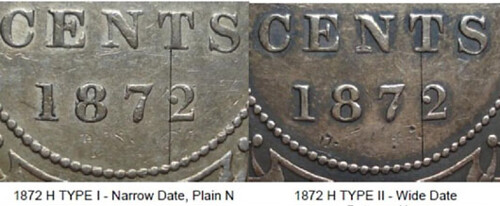
“The contents of this book will be limited to those varieties which occurred as a result of the intentional changes and modifications made to the production dies. I will not be considering mint errors unless, they are significant and unusual or if their origins are questionable.
“It was nearly five years ago when I purchased an 1888 Newfoundland 20-cent coin, which struck me as looking a bit odd but at the time, I really couldn't say why it seemed particularly different. I already had an 1888 example in my collection but I was looking for an upgrade and this new coin was to be the replacement. It wasn't until I placed the two coins side by side, before I was really able to identify exactly what that difference was. The date and specifically the 8s were different! My new coin had two short, stubby little 8's that were nearly touching each other, whereas, the original one had tall, elegant and well spaced 8's.
“Originally, I had focused my search on the Victoria 20-cent coins but I quickly expanded my areas of interest into the 10- and 50-cent Newfoundland series as well. Eventually, I plan cover all of the Newfoundland decimal coinage but it will undoubtedly take many more years of research before I have achieved a comprehensive volume of Newfoundland varieties. I know that I still have a lot of ground to cover but I feel that I now have enough material to produce a first edition, with others to come in the future. This first book was originally to be dedicated to the Victoria series but it has now been expanded with the inclusion of a very comprehensive George VI section. Perhaps there will even be a few other surprises by the time I get this one published.
To read the complete article, see: A New Look At Newfoundland Varieties
BOOK REVIEW: JOHN MERCANTI’S AMERICAN SILVER EAGLES
Louis Golino writes:
I wrote an article about the new book on Silver Eagles by John Mercanti and Michael Standish that was published in Coin Week, where I write a regular column called "The Coin Analyst."
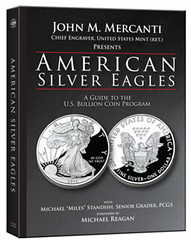 John Mercanti, who served as the U.S. Mint’s 12th Chief Engraver until his retirement in 2010, holds the distinction of having designed more U.S. coins and medals than any other employee of the Mint in its 220-year history. In his new book for Whitman Publishing, American Silver Eagles: A Guide to the U.S. Bullion Coin Program, that was released in November, Mercanti teams up with Michael “Miles” Standish, senior coin grader at PCGS and a leading expert on modern coins, who has graded over six million coins during his career, to produce a definitive guidebook on American silver eagles.
John Mercanti, who served as the U.S. Mint’s 12th Chief Engraver until his retirement in 2010, holds the distinction of having designed more U.S. coins and medals than any other employee of the Mint in its 220-year history. In his new book for Whitman Publishing, American Silver Eagles: A Guide to the U.S. Bullion Coin Program, that was released in November, Mercanti teams up with Michael “Miles” Standish, senior coin grader at PCGS and a leading expert on modern coins, who has graded over six million coins during his career, to produce a definitive guidebook on American silver eagles.
A reference book focusing on silver eagles is long overdue. The coin is one of the most widely traded silver bullion coin in the world, with more than 300 million examples in existence, and it is the most widely collected modern American coin. It is the modern American silver dollar, and in many ways, as I have argued before, the modern-day equivalent of the Morgan silver dollar. Moreover, in the view of Eric Jordan, the burnished uncirculated versions that have been issued since 2006 in much smaller numbers than the bullion and proof examples, are the modern equivalent of Carson City Morgan dollars, which were minted in smaller numbers than Morgan dollars minted at other branch mints.
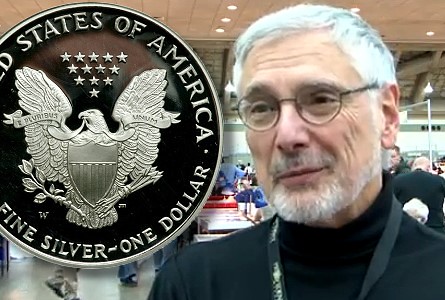
Reading the book one learns how the American silver eagle coin program came into existence. It was authorized in a provision that was part of the 1985 Liberty Coin Act, which created the three Statue of Liberty commemorative coins that were issued in 1986. The provisions in that legislation that authorized the American silver eagle program specified that the silver had to come from the nation’s silver stockpile, specified the fineness and other technical aspects of the coin, the pricing formula, and said no coins could be sold before September 1, 1986. The silver eagle legislation was signed into law by President Ronald Reagan on July 9, 1985, and President Reagan’s oldest son, Michael, wrote the foreword for this book.
A fascinating aspect of the creation of the coin, and one which in some ways reinforces the parallel with the Morgan dollar, is that the coin was created as a means of disposing of excess silver bullion from the stockpile that had been amassed as part of the National Defense Stockpile, which as the book explains, several presidential administrations believed were in excess of the likely strategic need for the metal.
This book is a real pleasure to read, especially because of the lavish illustrations and the coffee-table format. It includes an eight-page gallery that depicts the numerous coins and medals Mercanti designed during his almost forty year career at the Mint.
It also includes many informative sidebars that explain important aspects of the coin design and issuance process, the minting process, and the history of silver eagles. For example, there is a useful discussion of the Commission on Fine Arts and the Citizens Coinage Advisory Commission, which are the two commissions that review all coin and medal designs and make recommendations to the Mint and the Treasury Secretary about which designs should appear on our coinage.
It is well known that Mercanti created the heraldic eagle design for the silver eagle’s reverse, which he discusses in detail in the book. What is less well known is the more subtle modifications he made to the original Adolph Weinman design used for the coin’s obverse. The book includes side by side photos of the original and modernized images, which shows how they differ.
To read the complete article, see:
The Coin Analyst: John Mercanti’s Silver Eagle Guidebook
(www.coinweek.com/books-2/the-coin-analyst-john-mercantis
-silver-eagle-guidebook/)
To read earlier E-Sylum article, see:
NEW BOOK: AMERICAN SILVER EAGLES: A GUIDE TO THE U.S. BULLION COIN PROGRAM
(www.coinbooks.org/esylum_v15n40a03.html)
BOOK REVIEW: AMERICAN SILVER EAGLES - THE MERCANTI PERSPECTIVE
(www.coinbooks.org/esylum_v15n46a08.html)
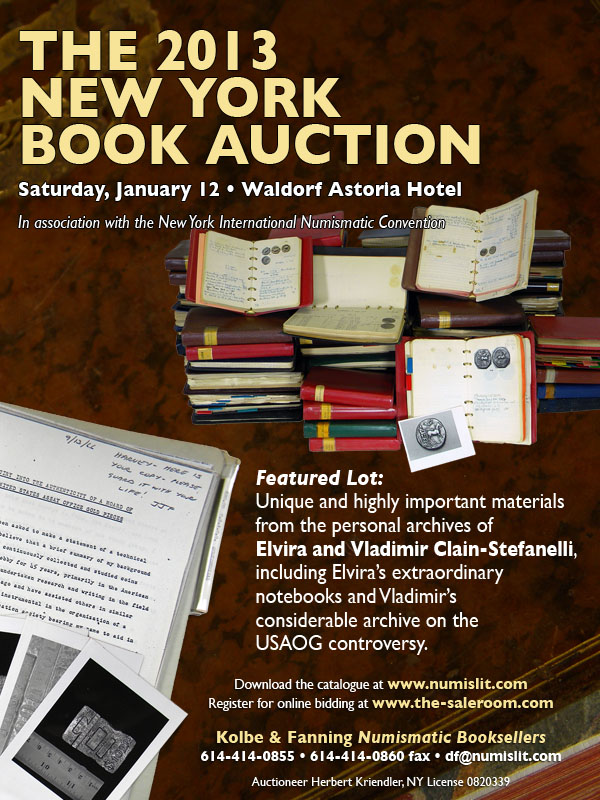
PAUL KOPPENHAVER 1932-2012
Julian Leidman posted on the Collector's Universe Forum:
Passed away on Saturday, Dec. 1 , at age 80, after 2 recent strokes. He was PNG Executive Director for over 17 years and was a close personal friend of Abe Kosoff, who founded the PNG. Paul was an expert and dealer in exonumia, before it became fashionable. He was previously part owner of the Long Beach Coin Show, having purchased it with Ron Gillio from Sam Lopresto. He leaves his wife Glenda, a son and a daughter.
Dave Schenkman writes:
I was real sorry to hear the sad news. I knew him for many years, although just from attending shows and an occasional phone call. We actually incorporated a business with Roy Van Ormer many years ago, but never did anything with it. Somewhere around here I think I still have the stock certificate.
Dave Bowers writes:
I first met Paul Koppenhaver in the 1970s when he operated the Coin Haven, a dealership in Van Nuys in the valley across the mountains from Los Angeles. His wife, Glenda, assisted. Paul dealt in many things, and once advertised that he specialized in Charlotte, Dahlonega, and Carson City gold coins, United States type coins, medals, tokens, United States currency, sutler scrip and Western Americana.
By mail order he conducted sales, particularly rich in token and medals -- I don’t recall a great deal in terms of branch mint gold, for example. Over a long period of years he had many important Civil War tokens, Hard Times tokens and other items, and I made frequent purchases from him. Later he was named as executive director of the Professional Numismatists Guild. With the aid of Glenda, he arranged for convention set ups, dealt with the American Numismatic Association, sold bourse tables, processed membership applications, facilitated arbitrations, and did just about everything else.
When I was president of the ANA 1983-1985 I worked with him on many occasions on convention planning. Always he was responsive and energetic with the PNG position well thought-out and presented. In the mid 1990s he exited the position. I recall there was some sort of disagreement about compensation. Later, Bob Bruggeman took the post, a fine choice as Bob had long experience in conventions, dealing with dealers, and setting up security arrangements. Bob is in that post today.
In 1989 the American Numismatic Association awarded its Medal of Merit to him. Paul was always rather quiet, did not boast of his accomplishments, and often to learn if he had a particularly choice or rare token or medal I had to question him. Others probably would have approached me with a sales talk! He was highly admired in his time, not only by his numismatic customers, but also by members of the Professional Numismatists Guild as he guided it through one of the periods of its greatest growth. He will be missed by all who knew him.
GERALD JOHNSON 1928 - 2012
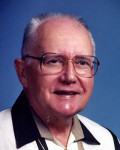 Gerald E. "Gene" Johnson, 84, 1921 Chase Street, a lifelong resident of Wisconsin Rapids, died Saturday, November 24, 2012 at the Odyssey Hospice House, Palm Springs, CA.
Gerald E. "Gene" Johnson, 84, 1921 Chase Street, a lifelong resident of Wisconsin Rapids, died Saturday, November 24, 2012 at the Odyssey Hospice House, Palm Springs, CA.
He was employed at the Biron Division of Consolidated papers, working 43 years in the quality control department until his retirement in 1990. Drafted into the army in November of 1950, he served 11 months as a combat mortar man in Korea.
A founding member of the Numismatists of Wisconsin in 1960, he served in all the elective offices of that organization, and edited their quarterly news magazine for over fifteen years.
A nationally known historian and numismatic writer, in 1967 he published the first state trade token book, "Trade Tokens of Wisconsin," a pioneer cataloging effort that led to listings that now encompass token catalogs from thirty two states nationally. Frequently honored for his writings, Johnson received the Fare Box Literary award in 1966 and 1977, the Seigel Literary Award in 1979, the Numismatic Ambassador Award in 1980, and in 1995, was honored by the Literary Guild for the best numismatic article published in the United States.
Clifford Mishler writes:
Gene was 84, having been born in Wisconsin Rapids on March 5, 1928; he died on Saturday, November 24, 2012, at the Odyssey Hospice House in Palm Springs, Calif., where he and his wife, Irene, have been wintering for the past 12-15 years or so.
His memorial service is set for 2:00 p.m. on Saturday, December 8, at the Herman-Taylor Funeral Home in Wisconsin Rapids; I plan to attend the funeral, as will Chet Krause and a few other friends from Iola.
Jeff Reichenberger adds:
I was saddened to hear of the passing of a great Wisconsin numismatist, Gerald ‘Gene’ Johnson. I’ve only known Gene briefly but his kindness left me with a cherished memory. We met a few years ago at a coin show and ceremonial event commemorating the 50th anniversary of Wisconsin’s state coin club ‘Numismatists Of Wisconsin’, or N.O.W. He was one of the founders of the club and among several of them who were there to celebrate the anniversary.
Gene was the former editor and prolific writer for the quarterly journal ‘N.O.W. News’. It seemed he had an article in every issue, often about an obscure Wisconsin related numismatic item, but not always; in his very last article, this year's winter issue – just received in the mail – he covered the interesting ‘Parnell and Gladstone’ tokens of the 1870’s. He had an easy style of researching and breaking down information to make it readable and interesting.
I had the pleasure of spending an afternoon with him at his home to discuss an article he wrote, which I desired to research further. He was open and cordial welcoming me into his home office filled with file cabinets and books. He gave me sage advice on how and where to dig for information, and he was always helpful and happy to pass along his knowledge in foregoing correspondence.
Of course he is most known for authoring ‘Trade Tokens of Wisconsin’ in 1967 with major revisions in ’77 and ’93. These are the bibles for collectors of the subject.
Gene was a true gentleman. Thank you Gene, you will be missed.
To read the complete obituary, see: Gerald Johnson (1928 - 2012) (www.legacy.com/obituaries/wisconsinrapidstribune/obituary.aspx?n=gerald-johnson&pid=161490338)
NOTES FROM E-SYLUM READERS: DECEMBER 9, 2012
The Ship of Gold Book
 Jeffrey P. LaPlante writes:
Jeffrey P. LaPlante writes:
I ended up buying Ship of Gold to read and it grabs you right of the bat, thank you for the excellent suggestions as always, you the gang, the NBS, and the E-Sylum folks are on top of things.
To read the earlier E-Sylum article, see: MORE ON THE SHIP OF GOLD FILM (www.coinbooks.org/esylum_v15n49a10.html)
TWO EARLY U.S. COINAGE DESIGNS THAT NEVER WERE
I had asked Joel who was responsible for the nice artist's renderings of the proposed coins, and learned they were done by Pete Smith. Nice work! -Editor
 Every collector of U.S. coinage is
familiar with the famous 1792 “Chain” half
disme and the renowned 1793 “Miss Justice”
large cent. That is, every numismatist
would have been familiar with these
designs had certain U.S. Senators gotten their
way on January 9, 1792, when legislation to create
the United States Mint was being debated in
Philadelphia’s Congress Hall.
Every collector of U.S. coinage is
familiar with the famous 1792 “Chain” half
disme and the renowned 1793 “Miss Justice”
large cent. That is, every numismatist
would have been familiar with these
designs had certain U.S. Senators gotten their
way on January 9, 1792, when legislation to create
the United States Mint was being debated in
Philadelphia’s Congress Hall.
Proposed for the reverses of silver and copper coins, respectively, the Chain and Miss Justice designs were neither original, nor ultimately accepted, but certain elements of both eventually were incorporated into coins the Mint actually produced. How all this happened— and how some of it didn’t—makes for a fascinating tale from the prehistory of the U.S. Mint.
The first of two proposed amendments, in its entirety, read:
On motion, to amend section 9, of the original bill, as follows: Line 9, strike out the words “and silver.” And after the word “America” in the 11th line, erase to the end of the section; and in lieu thereof insert, “And upon the reverse of each of the said silver coins, in the centre of the exergue, there shall be an engraving of two hands united, and around the margin of the piece as many circles linked together as there shall be states in the union at the time of the coinage, each circle containing the initial letters of the name of it[s] respective state; and between the representation of the united hands and the circles aforesaid, there shall be this inscription in an annular form, “Dollar of the United States of America,” where the coinage shall be of a dollar, but where the coinage shall be of parts of a dollar, expressing the same accordingly.
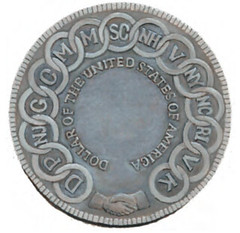 Had this proposed reverse been adopted, the
design would have taken the form of a ring within
a ring, with clasped hands in the exergue below.
The outer ring would have consisted of a series of
interlocking circles, each enclosing the initial letter
of a state (or, in the case of two-word states,
like New York, the initial letters). This outer ring
would not form a full circle, since it would be
interrupted by the hands. The inner ring would
consist of the words identifying the coin’s denomination
and country of origin.
Had this proposed reverse been adopted, the
design would have taken the form of a ring within
a ring, with clasped hands in the exergue below.
The outer ring would have consisted of a series of
interlocking circles, each enclosing the initial letter
of a state (or, in the case of two-word states,
like New York, the initial letters). This outer ring
would not form a full circle, since it would be
interrupted by the hands. The inner ring would
consist of the words identifying the coin’s denomination
and country of origin.
Since the first U.S. coin, the 1792 half disme, was not struck until July 11-13, its reverse would have had 15 links in the outer ring, one for each of the 13 original states, plus one for Vermont (admitted March 4, 1791) and one for Kentucky (admitted June 1, 1792). It would have been challenging indeed to include all this and the legend HALF DISME OF THE UNITED STATES OF AMERICA on the tiny 17.5mm coin.
There can be little doubt about the Senators’ inspiration for the silver reverses: the 1776 Continental Currency “dollar” and the 1787 Fugio “cent.” The dollar depicted a ring within a ring, with the outer circle composed of 13 interlocking links, each enclosing the full name of one of the original 13 states. The inner circle featured the words AMERICAN CONGRESS. The cent was similarly designed, though the links on a variety bearing the legend UNITED STATES (instead of AMERICAN CONGRESS) are blank.
Joel adds:
The renderings are Pete's original oil paintings. Two of Pete's other oil paintings, one showing the Front Building, and the other the entire campus of the first Mint, are found on pages 60 and 61 of The Secret History of the First U.S. Mint.
QUERY: WERE MANY NORWEB CANADIAN LARGE CENTS SLABBED?
I recently purchased a Canada large cent in NGC MS65 RB condition and pedigreed to the Norweb collection. I traced it through the auction catalogs in my reference library to the Farouk sale of 1954, which I found to be quite thrilling and fascinating.
I knew Dave Bowers' firms were involved in selling most of the Norweb holdings, and wondered if firm had NGC grade any or all of the Norweb coins or just the Canadian coins, and if the Norweb provenance was printed on each label.
I contacted Dave Bowers and he said his firm did not slab any of the Norweb coins before or after the auctions. Which begs the question, how would a third-party grader like NGC know a coin was pedigreed to Norweb unless they were either at the auction or were working for the auction firm.?
I will contact NGC and see if anyone there knows what's what. In the meantime perhaps a question for the E-Sylum readers would be - Does anybody know of any other coins from the Norweb sales that were slabbed, or more to my search question, were any Canadian Large cents other than the one I have slabbed? I realize this might take a little numismatic sleuthing, but someone surely must remember. It was only about 15 years ago I think, maybe the 1996 timeframe.
QUERY: CONTACT MARKS: WHERE AND HOW?
A group of collectors was deep in conversation when the subject of Contact Marks came up. These were seasoned collectors who were well versed in the jargon of coin collecting and numismatics.
But they could not agree on the definition of Contact Marks. They all agreed it means a slight degree of wear They could not agree on where and how this occurs. One person took the position it was similar to Cabinet Friction where it occurs only when a numismatic item rests on a flat surface and moves around like in a cabinet tray, or loose from its holder, causing the very light abrasion on the high points.
Another person took the position it could come from, say, knocking against other coins, like in a bag of coins. Similar to Bag Marks. Or in pocket change, like from keys or other pocket objects. It could occur at any place on a coin, not just the high points.
Both gentlemen were firm in their beliefs. Could knowledgeable E-Sylum readers chime in? Which meaning is your understanding of Contact Marks?
COPPERHEADS AND THE U.S. MINT OATH OF ALLEGIANCE MEDAL
I learned of this medal during my research of the Confederate cent several years ago. In August 1866, the American Journal of Numismatics published an article that referred to the U.S. Mint as the “copper-head factory,” a reference to Northerners with Southern sympathies. Obviously, this sentiment was part of the motivation for the Oath of Allegiance and the medal.
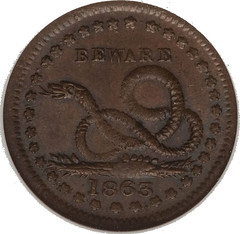 In 1863, a token was produced that had Andrew Jackson on one side and a coiled snake or the other side. The word “Beware” is on the snake side, which is often interpreted to mean Beware of the Snake. The correct interpretation is, Beware of the Copperheads.
In 1863, a token was produced that had Andrew Jackson on one side and a coiled snake or the other side. The word “Beware” is on the snake side, which is often interpreted to mean Beware of the Snake. The correct interpretation is, Beware of the Copperheads.
Although the Democratic party had broken apart in 1860, during secession Democrats in the North were generally more conciliatory toward the South than the Republicans. They called themselves Peace Democrats; their opponents called them Copperheads because some wore copper pennies as identifying badges.
 The most prominent Copperhead leader was Clement L. Vallandigham, a U.S. Representative from Ohio. After leaving the House of Representatives, he was arrested on May 5, 1863, denied a writ of habeas corpus, convicted by a military tribunal and sentenced to two years in prison. All of this was for speaking out against the war. Not wishing to create a martyr, Lincoln sent Vallandigham through the lines to the Confederacy, from where he travelled by ship to Canada. After the war, he returned to Ohio and was buried in Dayton in 1871.
The most prominent Copperhead leader was Clement L. Vallandigham, a U.S. Representative from Ohio. After leaving the House of Representatives, he was arrested on May 5, 1863, denied a writ of habeas corpus, convicted by a military tribunal and sentenced to two years in prison. All of this was for speaking out against the war. Not wishing to create a martyr, Lincoln sent Vallandigham through the lines to the Confederacy, from where he travelled by ship to Canada. After the war, he returned to Ohio and was buried in Dayton in 1871.
To read the earlier E-Sylum article, see: THE U.S. MINT OATH OF ALLEGIANCE MEDAL (www.coinbooks.org/esylum_v15n50a12.html)
YALE COIN COLLECTION OPENS IN NEW ART MUSEUM

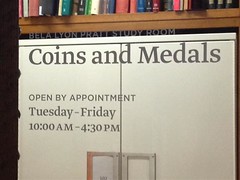
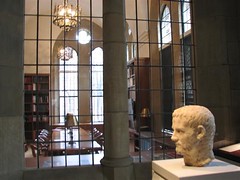 Bela Lyon Pratt would be proud. The numismatic department in Yale University's newly refurbished and expanded Art Museum is named in honor of the Boston sculptor who numismatists know as the designer-sculptor of the incuse Indian Head series of gold half and quarter eagle coins of 1908-1929.
Bela Lyon Pratt would be proud. The numismatic department in Yale University's newly refurbished and expanded Art Museum is named in honor of the Boston sculptor who numismatists know as the designer-sculptor of the incuse Indian Head series of gold half and quarter eagle coins of 1908-1929.
Pratt, a Yale alumnus, was also the creator of sculpture on the Yale campus including a heroic statue of Nathan Hale. An exhibit of two dozen of Pratt's coins and medals is in the featured showcase at the entrance to the coin and medal department. For years this group of Pratt's coins and medals were exhibited just outside the university president's office, so there is great pride in a favorite son's numismatic accomplishments at the highest university level.
 Above that showcase is a cast bronze plaque bearing Pratt's portrait in a three-quarter standing view, the 1910 creation of his student, Richard Henry Recchia. That very plaque was familiar to me, as I had auctioned it May 14, 1989 (Collectors Auction Limited #31 lot 295) with a full page description and its illustration on the catalog's cover.
Above that showcase is a cast bronze plaque bearing Pratt's portrait in a three-quarter standing view, the 1910 creation of his student, Richard Henry Recchia. That very plaque was familiar to me, as I had auctioned it May 14, 1989 (Collectors Auction Limited #31 lot 295) with a full page description and its illustration on the catalog's cover.
The plaque was purchased by New York City numismatist Tony Terranova who hung it on his dining room wall. I mentioned this plaque in conversation with Yale curator William E. Metcalf as early as 2008. "I want that plaque for the museum." said Bill. I gave him Tony's contact information and Bill negotiated its purchase. Tony graciously gave up ownership and possession for such a permanent and important purpose to serve as the keystone exhibit at Pratt's namesake numismatic department.
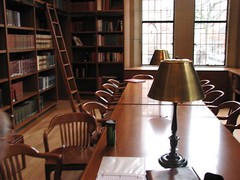 Actually two rooms, the coin and medal department is a combination office-vault, and a study room, which is officially the Bela Lyon Pratt Study Room. Here is where the library is located with book shelves 15 feet high attained by a moveable library ladder on three sides of the long room. Library table in the center with 16 chairs where university students -- and visiting scholars -- examine the department's treasures, drawn from both coin cabinets and library shelves.
Actually two rooms, the coin and medal department is a combination office-vault, and a study room, which is officially the Bela Lyon Pratt Study Room. Here is where the library is located with book shelves 15 feet high attained by a moveable library ladder on three sides of the long room. Library table in the center with 16 chairs where university students -- and visiting scholars -- examine the department's treasures, drawn from both coin cabinets and library shelves.
Outside these rooms is the exhibit area assigned to the coin and medal department. At present with six showcases now filled with some of Bill's choice items from the collection's ancient coins. This area is open to the public for viewing at all time the museum is open.
The collection contains nearly 100,000 items, nearly half of which are ancient coins, but with extensive holdings across the spectrum of numismatics. The collection is the accumulated accretion from over 200 years of alumni donations dating from the early formation of the university itself in 1802. But curator Metcalf points out it is not all alumni donations, as specific collections have come from California and elsewhere for a variety of reasons.
It is difficult not to acquire the same items a second or more times, explained Bill. For example they have four sets of The Society of Medalists, the leading art medal series in America, now ideally located in an Art Museum.
It wasn't always so. The collection had been housed in a special room in the Sterling Library at the center of the Yale campus. A similar configuration of vault-office room, its second was the numismatic library. It was last administered by numismatist John Burnham, who left in 1995. For reasons of poor security -- the collection's Brasher Doubloon and others had disappeared over the years. Fortunately the Brasher Doubloon was later recovered (and sold at auction).
It made sense to transfer the coin collection to the Art Museum. But the Sterling Library demanded to retain possession of the numismatic books. Bill had to start building a numismatic library all over again. While deep in ancient numismatics, the library has not grown to full capacity for modern numismatics. [Note to current authors: if your book covers important reverences to art and numismatics a copy could be donated here particularly for university level study.]
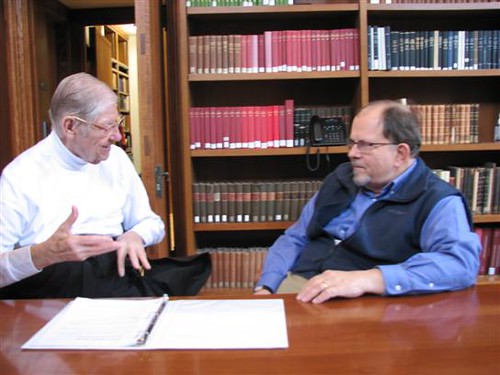
Dick Johnson and Bill Metcalf
Curator William E. Metcalf, is the former chief curator at the American Numismatic Society and long involved in academic numismatics. In fact, his curriculum vitae -- academic record of educational positions, publications, speeches, professional services, honors and awards -- is nine pages long, the longest I have observed in the numismatic field. Those are rare credentials!
In fact, he holds two positions at Yale -- that's a rare situation at the university! He is Professor Adjunct of Classics and also Ben Lee Damsky Curator of Coins and Medals. He teaches classes obviously in classics for Yale students and also has the title and keys to the coin and medal department in the Art Museum.
Bill is affable and extremely knowledgeable, such a delightful conversationalist. Here is someone, I found, who could discourse on just about any level of numismatics. Ancient numismatics (outside my knowledge) to esoteric subjects as the use of the Janvier reducing machine in America (of which I am conversant), Bill is expert in all. Right man for the position as coin and medal curator at such a prestigious institution. (Can we now thank those thousands of donations by alumni over the years at this point?)
The new Art Museum is an amalgamation of three buildings. The old Yale Art Gallery is the centerpiece, it took over Street Hall to one side, and an entirely new building was constructed on the other side, the modern Kahn Building. To the credit of the architects they have merged all three into one large showplace. It occupies one entire block on Chapel Street in New Haven (despite its singular address 1111 Chapel) it actually has a street running through the middle of the New building!
The Pratt Coin and Medal Department with vaulted windows looks out on both Chapel Street and High street tunneling through the building at street level.
On my first visit to the New Art Museum yesterday I found it ample. Here is where expansion can occur for the next 200 years. Here is where scholars can be drawn for future studies. Here is where students with open minds can be filled with the knowledge of art -- and for our interest -- with numismatic knowledge. Here is where the public can come and see the treasures of the ages. We are now satisfied the numismatic department was moved from the library to an art museum for all the right reasons. Good move.
This week, in week-long celebration of the reopening of the museum, artists, academics and friends will gather to join with Yale in celebration of a vibrant new institution. The Art Museum has a new home.
I had a chance to chat with the institution's director, Jock Reynolds, before I left. The Art Museum is in very competent hands.
THE BOOK BAZARRE
THE LABOR EXCHANGE NOTES OF GIOVANNI DEBERNARDI
As E-Sylum readers know, one of my collecting interests is Labor Exchange notes. Recently I added a couple Reading, PA notes to my collection and decided to spend some time doing an Internet search to learn a little more about these late 19th-century U.S. notes.
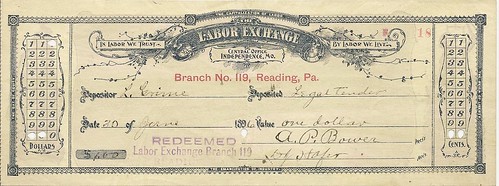
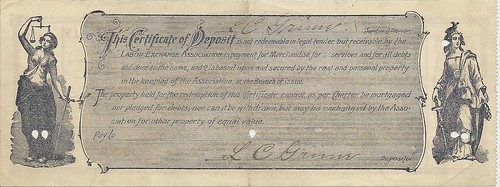
I learned that this incarnation of the labor exchange was founded in 1889 by Giovanni Battista DeBernardi of Independence, Missouri, and the Panic of 1893 spurred a great deal of interest in it. Some 325 locals of the Labor Exchange were scattered across the country, doing business in at least thirty-three states and claiming some fifteen thousand members. Only a subset of these were active enough to actually issue labor exchange notes.
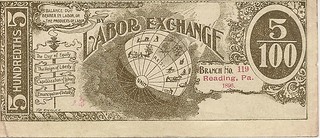

I discovered an entry in the American Numismatic Society DONUM catalog for a 1998 article by Steve Whitfield, and ANS librarian Elizabeth Hahn kindly scanned a copy for me. I emailed Steve, an E-Sylum readers, for more information and learned that information on the labor exchange notes would be included in the upcoming Neil Shafer book on emergency scrip issues of 1893 to 1915.
Next I checked in with Neil Shafer, who writes:
Thanks for asking about the book. As a matter of fact, just last week my editor, Fred Reed, indicated that he had sent it all to McFarland, the publisher, so we are totally finished except for proofreading and updating the Index. Fred has done a magnificent job with a very difficult manuscript, and we are looking forward to publication some time in 2013.
There are several supplemental sections in the book. Fred and Steve Whitfield arranged for Steve to prepare a section on Labor Notes for the book, and I was happy to agree. From what I recall it covers these pieces you have, and is probably close to definitive on the series.
Now I can't wait to finally see the book! We'll all look forward to its publication next year.
PICTURE GALLERY OF U.S. NUMISMATIC GREATS
QUICK QUIZ: Who can guess the names of these folks (no fair peeking)! -Editor
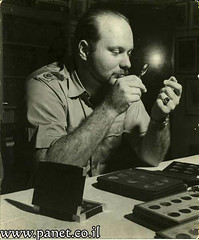
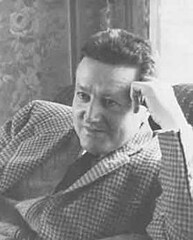
Allen, Leroy Van
Bass Jr., Harry Wesley
Bowers, Q. David
Boyd, F.C.C.
Brand, Virgil M.
Breen, Walter
Buss, Jerry
Carter Sr., Amon G.
Cohen, Roger
Criswell Jr., Grover, with his wife
Davis, David J.
DiBello , Gaston
Ebsen, Buddy
Eliasberg Sr., Louis E.
Farouk, King of Egypt
Ford , John J.
Garrett , John Work
Gobrecht, Christian
Saint-Gaudens, Augustus
Green, Colonel Edward Howland Robinson
Kosoff, Abe
Kneass, William
Logan, Russell J.
Longacre,
Lovejoy, Allen F.
McCloskey , John W.
Mehl, B. Max
Newman, Eric P.
Norweb, Mrs.
Ostheimer III, Alfred J.
Norweb Sr., Ambassador R. Henry
Pittman, John Jay
Raymond, Wayte
Roper, John L.
Schook, Florence (school of numismatics)
Sheldon, Jr., Dr. William Herbert
Stack, Harvey
Stickney, Matthew A.
Subjack, William J.
Valentine, Daniel W.
To read the complete article, see: numismatic greats peekture thread (forums.collectors.com/messageview.cfm?catid=26&threadid=874231)
2013 COIN OF THE YEAR AWARD WINNERS
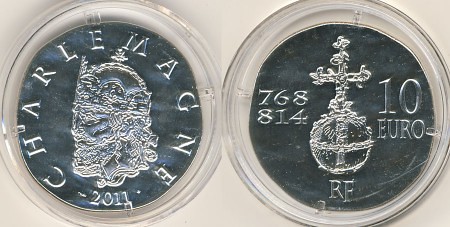
Best Crown
Monnaie de Paris – 2011 Charlemagne 10 Euro Silver Coin
The second issue in a series “From Clove to Republic – 1500 Years of French History” which featured Charlemagne. The coin is minted with a special process which makes it appear to be hammer struck, as it would have during the time of Charlemagne. Struck in 90% silver, the coins have a weight of 22.2 grams and diameter of 27 mm. The mintage is limited to 20,000 pieces.
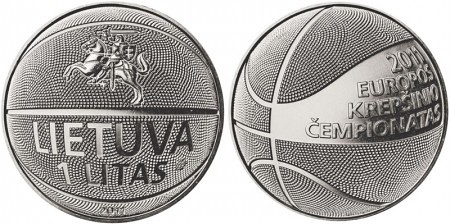
Best Trade Coin
National Bank of Lithuania – 2011 Basketball 1 Litas Coin
The obverse design features a stylized basketball with the symbol of the state emblem of the Republic of Lithuania. The reverse features another view of a basketball with an inscription which translates to “The European Basketball Championship 2011″. The coins are struck in 75% copper and 25% nickel with a weight of 6.25 grams and diameter of 22.3 mm. The mintage was 1,000,000 pieces.
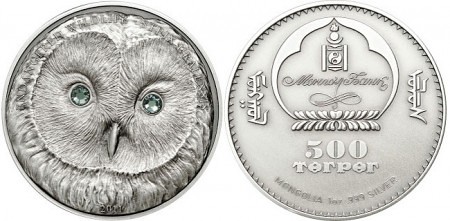
Most Popular Coin
National Bank of Mongolia – 2011 Ural Owl 500 Togrog Silver Coin
A close up of the Ural Owl is shown with its eyes created from two dark Swarovski Elements.
Struck in 99.9% silver with an antique finish, the weight is 1 troy ounce and diameter is 38.61 mm. The mintage is indicated at 2,500 pieces.
To read the complete article, see:
Images of 2013 Coin of the Year Award Winners
(world.mintnewsblog.com/2012/12/images-of-2013-coin
-of-the-year-award-winners/)
BRITISH MUSEUM EXHIBITS ST ALBANS ROMAN COIN HOARD
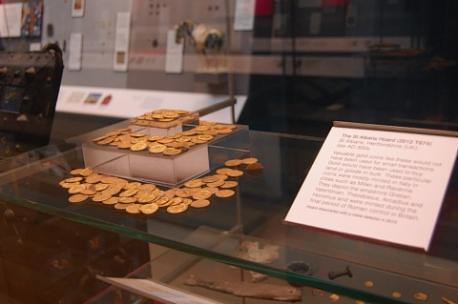
A hoard of Roman coins discovered in St Albans has gone on display in the British Museum.
The 159 coins, known as solidus, were found by the council’s museum service on private land in the north of the district at the beginning on this month.
The fourth century coins went on display on Tuesday, December 4 in the Citi Money Galley, which focuses on treasure and hoarding.
They are expected to remain on show until early January.
Henry Flynn, a museum assistant who has worked on the display, said: “If you look closely at the coins in the case you will see that many of them are still muddy.
“They are all legible and can be identified, but the traces of dirt nicely show that this is a very recent find that came from the ground.
“Many people don’t realise how much work goes into treasure at the British Museum, particularly the conservation work, so hopefully this changing display will be of great interest to the public.”
The coins, which were one of the biggest collections to ever be found in the UK, were minted during the final period of Roman control in Britain.
They were found scattered across a large area and experts believe they were disturbed during the last couple of hundred years by quarrying or ploughing.
They depict the emperors Gratian, Valentinian, Theodosius, Arcadius and Honorius.
To read the complete article, see:
Roman coins found in St Albans go on display in British Museum
(www.stalbansreview.co.uk/news/10094315.Roman_coins
_found_in_St_Albans_go_on_display_in_British_Museum/)
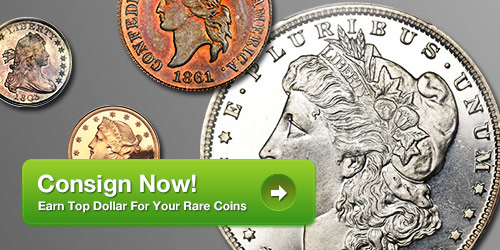
THE BATH ROMAN COIN HOARD
 A £50,000 lottery grant could help keep a hoard of Roman coins in Bath.
A £50,000 lottery grant could help keep a hoard of Roman coins in Bath.
The Beau Street Hoard of 20,000 silver coins was discovered by archaeologists in 2007 and is thought to be the fifth largest find of its kind in the UK.
Some of the coins date back as far as 32BC and are currently being cleaned at the British Museum.
The initial support from the Heritage Lottery Fund could lead to a further £480,000 grant in 2013.
Bath and North East Somerset Council said it wanted to develop learning and community activities around the hoard.
A mobile roadshow would visit towns and villages around Bath and the coins would then eventually be displayed at the Roman Baths.
Richard Bellamy, of the Heritage Lottery Fund South West, said: "The Beau Street Hoard is a wonderful discovery.
"It has the potential to develop our understanding of one of the most fascinating periods in the history of Bath."
To read the complete article, see: Lottery grant could help buy Bath Roman coin hoard (www.bbc.co.uk/news/uk-england-somerset-20639557)
SPINK SELLS RICHARD III COIN FOUND NEAR BATTLEFIELD
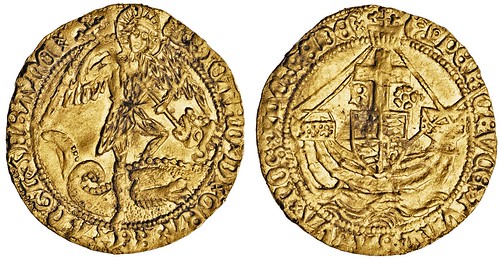
A gold coin discovered near the site of the famous Battle of Bosworth in Leicestershire, bearing Richard III’s personal emblem of the boar, has sold for £36,000 to a private collector, against a pre-sale estimate of £12-15,000 at Spink in London. It went under the hammer in Spink’s Ancient, English & Foreign Coins and Commemorative Medals two day sale in London, on December 4th & 5th, 2012.
While badges, sword mounts and cannonballs, as well as other coins have been found near the site of the battle before, the discovery of a contemporary gold coin is most unusual. As well as bearing the personal boar’s head emblem of Richard III (1483-85), this very rare coin is in pristine condition, with few signs of wear and tear, suggesting it was recently made when lost. The coin, an Angel, dates from circa 1484 and features St. Michael spearing the dragon on reverse and a ship on the waves with a crucifix above a shield on the obverse.
Commenting on the sale, Spink coin specialist William MacKay, said: “There was fierce competition in the saleroom for this exceptional example of an historically important coin from an interesting find location. This is a fantastic result, which shows the demand continues to be strong for top quality, rare English gold coins.”
NUMISMATICS IN GOTHA
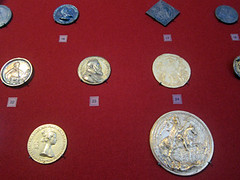 Today Gotha is a nice little town of some 50,000 inhabitants. However, in 1643 Ernst I of Saxe-Gotha decided to shape the place a capital that could keep up with other towns on an international level.
Today Gotha is a nice little town of some 50,000 inhabitants. However, in 1643 Ernst I of Saxe-Gotha decided to shape the place a capital that could keep up with other towns on an international level.
Ernst, as nearly all of his nine brothers, served as a colonel to the Swedish army during the Thirty Years’ War. Thus he knew the horror of the battle field and how much the civilians feared plundering. No wonder he yearned for another time and called the castle erected in an inherited territory ‘Schloss Friedenstein’ (‘Palace of the peace rock’). It was, indeed, conceived as a gigantic palace typical of the early baroque. Splendour took the place of actual power of which, most probably, the small Duchy of Saxe-Gotha was lacking.
Schloss Friedenstein was not only destined to live in. All institutions of the then new state were housed there, some rooms were intended for the administration of the country, other for the archives. The stables, the smithy and the arsenal made it clear that this place was the heart of the state’s military defence, too. A theatre which is still conserved, displayed the importance of the duke’s court to the artistic world.
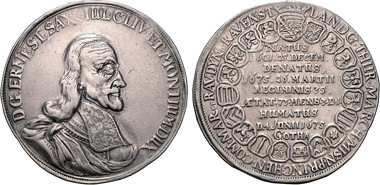
Ernst I the Pious, 1640-1675. Reichstaler 1675 in occasion of his death.
And, of course, the mint was placed as well in Schloss Friedenstein – at least for some years. It was located where you can find the restaurant today. The early coinage was definitely not economically relevant. These issues served as representative objects and displayed the duke as a pious man – the result is, indeed, that this is how he is still called today.
The representative rooms were really impressive and all the time, we came across busts of rulers known to us from coins.
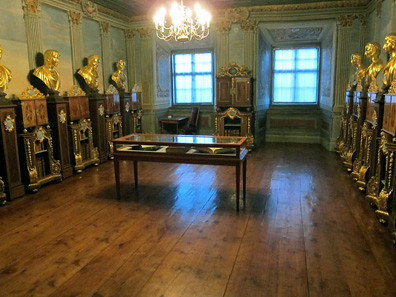
Coin Cabinet
One of them is this: Frederick II of Saxe-Gotha, or of Saxe-Gotha-Altenburg as he was called since 1672. He was very fond of numismatics and, in 1692, he appointed Ernst Tentzel curator of the coin cabinet. Tentzel was a famous numismatist who published the ‘Saxonia Numismatica’ which is, even nowadays, still a reference work. In 1712 Frederick II scored an incredible coup: he purchased the collection of count Anton Günther II von Schwarzburg-Arnstadt (1653-1716).
Ernst I (1601-1675) received a part of the Ernestine Cabinet of curiosities comprising, among other things, 516 coins and medals. It is really remarkable that this collection in Gotha exists, but particularly, how precisely we can describe all details of how it came to existence thanks to the sources at our disposition! 781 pieces were purchased between 1653 and 1656.
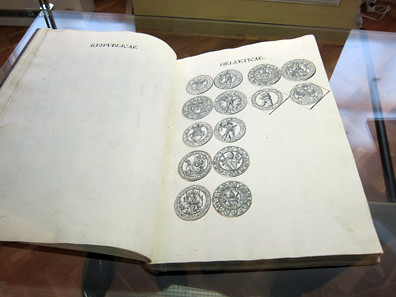
The son of Ernst I, Frederick I (1646-1691), was a passionate collector, too. He considered himself to be a baroque aristocrat, and he attempted to conceal his loss of power – provoked especially by the division of his father’s estate – by increasing his representation. Part of this conception of oneself was a coin collection. The duke enjoyed making an inventory of his coins and arranging them in order, as we learn from his diaries.
Frederick I passed on this pleasure in numismatics to his son Frederick II (1676-1732). In 1712, Frederick II succeeded in acquiring the collection of Anton Günther II, ruler of Schwarzburg, a collection that was known all over Europe. The latter had gathered this impressive collection with the help of the Parisian numismatist Andreas Morell (1646-1703).
The heirs of Frederick II kept purchasing material. However, it would be too long a list if we tried to enumerate all acquisitions. Those interested in this topic should read the brand-new book ‘Gothas Gold’ where Martin Eberle describes the history of the collection in all details.
To read the complete article, see: Numismatics in Gotha (www.coinsweekly.com/en/News/4?&id=1644)
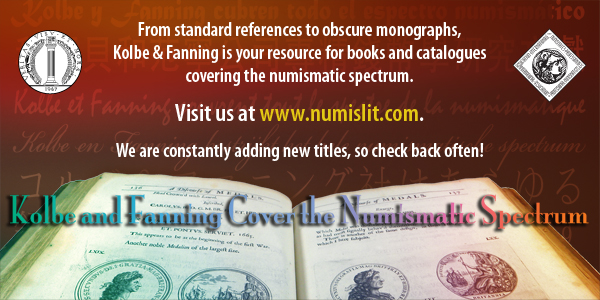
PLATINUM COIN "SOLUTION" TO U.S. DEBT CRISIS FLOATED
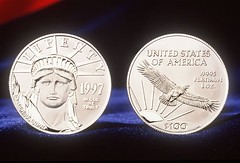 If President Obama wants to avoid an economic calamity next year, he could always show up at a press conference bearing two shiny platinum coins, worth… $1 trillion apiece.
If President Obama wants to avoid an economic calamity next year, he could always show up at a press conference bearing two shiny platinum coins, worth… $1 trillion apiece.
Okay, that sounds utterly insane. But ever since last year, some economists and legal scholars have suggested that the “platinum coin option” is one way to defuse a crisis if Congress can’t or won’t lift the debt ceiling soon. At least in theory.
The U.S. government is, after all, facing a real problem. The Treasury Department will hit its $16.4 trillion borrowing limit by next February at the latest. Unless Congress reaches an agreement to raise that borrowing limit, the government will no longer be able to borrow enough money to pay all its bills. Last year, Republicans in Congress resisted lifting the debt ceiling until the last minute — and then only in exchange for spending cuts. Panic ensued. So what happens if there’s another showdown this year?
Enter the platinum coins. Thanks to an odd loophole in current law, the U.S. Treasury is technically allowed to mint as many coins made of platinum as it wants and can assign them whatever value it pleases.
Under this scenario, the U.S. Mint would produce (say) a pair of trillion-dollar platinum coins. The president orders the coins to be deposited at the Federal Reserve. The Fed then moves this money into Treasury’s accounts. And just like that, Treasury suddenly has an extra $2 trillion to pay off its obligations for the next two years — without needing to issue new debt. The ceiling is no longer an issue.
“I like it,” says Joseph Gagnon of the Peterson Institute for International Economics. “There’s nothing that’s obviously economically problematic about it.”
In theory, this is much like having the central bank print money.
To read the complete article, see:
Could two platinum coins solve the debt-ceiling crisis?
(www.washingtonpost.com/blogs/wonkblog/wp/2012/12/07
/could-two-platinum-coins-solve-the-debt-ceiling-crisis/)
DRAMATIC LIBRARY PATRON RESCUE
Arriving back at the dorm late one evening, my roommate explained that she had gotten lost in the school library. No one was surprised since the library is large and has a confusing layout.
When I asked her how long it took her to find an exit, she admitted she hadn't actually found the exit herself. She'd used an emergency phone to call for help.
Puzzled, I asked, "How did your rescuers find you if you didn't know where you were?"
"Easy," she said. "I started reading titles of books around me, and they located my position from the card catalogue."
To read the complete article, see: Lost in Thought (www.gcfl.net/archive.php?funny=3939)
FEATURED WEB SITE: THE CANADIAN 1859 LARGE CENT
This week's Featured Web Site is James A. Haxby's Haxby Catalog of the Canadian 1859 Large CentThis site has been published to help identify and catalog each die and die combination used in minting the 1859 Narrow 9 Canadian large cents.

www.vickycents.com

